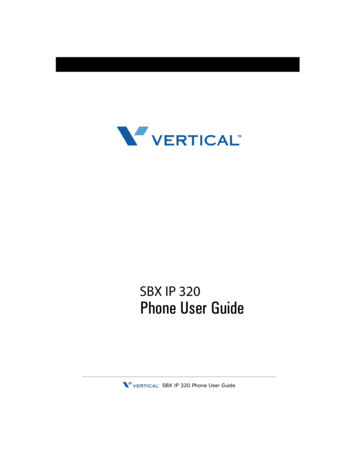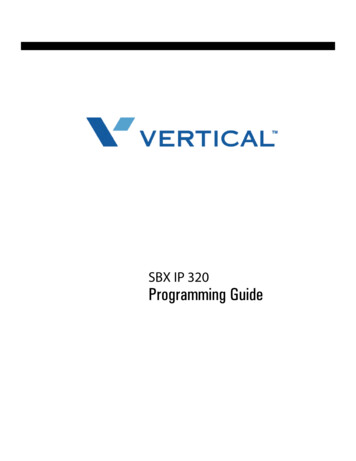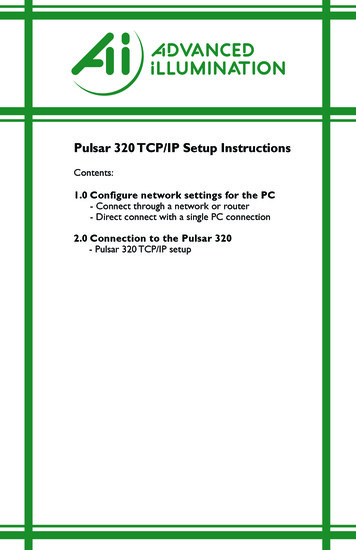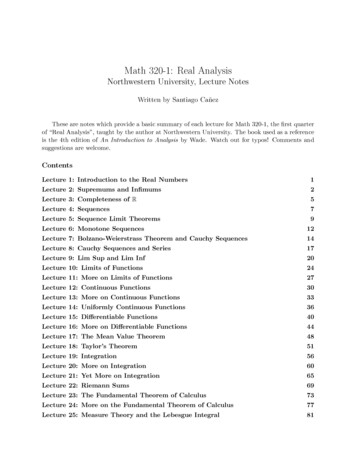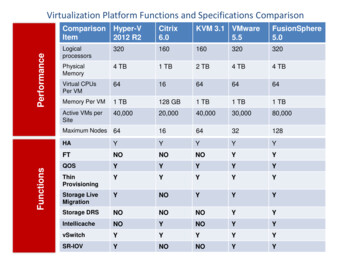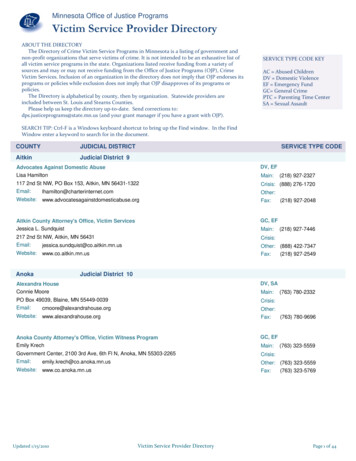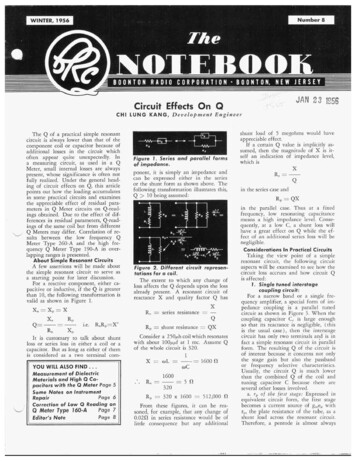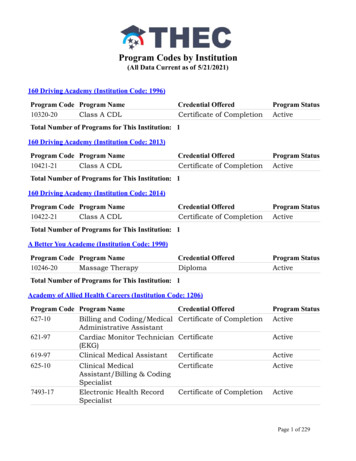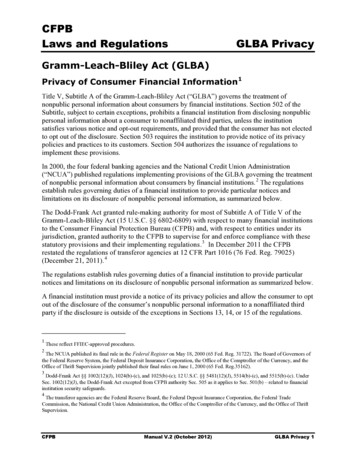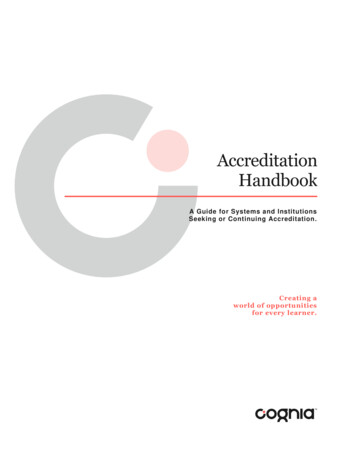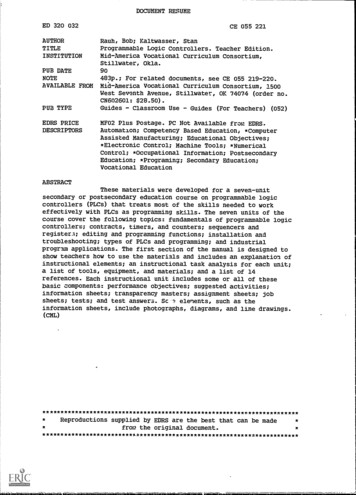
Transcription
DOCUMENT RESUMEED 320 032CE 055 221AUTHORTITLEINSTITUTIONRauh, Bob; Kaltwasser, StanProgrammable Logic Controllers. Teacher Edition.Mid-America Vocational Curriculum Consortium,Stillwater, Okla.PUB DATENOTEAVAILABLE FROM90PUB TYPEEDRS PRICEDESCRIPTORS483p.; For related documents, see CE 055 219-220.Mid America Vocational Curriculum Consortium, 1500West Seventh Avenue, Stillwater, OK 74074 (order no.CN602601: 28.50).Guides - Classroom Use - Guides (For Teachers) (052)MF02 Plus Postage. PC Not Available from EDRS.Automation; Competency Based Education; *ComputerAssisted Manufacturing; Educational Objectives;*Electronic Control; Machine Tools; *NumericalControl; *Occupational Information; PostsecondaryEducation; *Programing; Secondary Education;Vocational EducationABSTRACTThese materials were developed for a seven-unitsecondary or postsecondary education course on programmable logiccontrollers (PLCs) that treats most of the skills needed to workeffectively with PLCs as programming skills. The seven units of thecourse cover the following topics: fundamentals of programmable logiccontrollers; contracts, timers, and counters; sequencers andregisters; editing and programming functions; installation andtroubleshooting; types of PLCs and programming; and industrialprogram applications. The first section of the manual is designed toshow teachers how to use the materials and includes an explanation ofinstructional elements; an instructional task analysis for each unit;a list of tools, equipment, and materials; and a list of 14references. Each instructional unit includes some or all of thesebasic components: performance objectives; suggested activities;information sheets; transparency masters; assignment sheets; jobsheets; tests; and test answers. Sc-.? elements, such as theinformation sheets, include photographs, diagrams, and line ********************1:**************Reproductions supplied by EDRS are the best that can be madefrom the original ********x*********************
a0041) ALLEVIIHADI.FS isarea411it3a*I4;Ak.BEST COPY AVAILABLEU S. DEPARTMENT Of EDUCATIONOtit of Edocabor.al Unearth and ImprovementTIONAL RESOURCES INFORMATIONEDCENTEThis document has been reproduced asreceived Irom we person or organizationoriginating a0 Minor changes have been made to improvereproduction Quality2Pointsohnew or Opinion! MatedinthisdOcu.ment dO not escessarey represent WhamOERI position or policy"PERMISSION TO REPRODUCE THISMATERIAL IN MICROFICHE ONLYHAS BEEN GRANTED BYx-ze erJ--t.,TO THE EDUCATIONAL RESOURCESINFORMATION CENTER (ERIC)."
North DakotaSouth Dakota,5
PROGRAMMABLE LOGICCONTROLLERSWritten byBob RauhandStan KaitwasserEdited byDan FulkersonDeveloped byThe Mid-America vocational Curriculum Consortium, Inc.Board of DirectorsAnn Masters, Nebraska, ChairmanSylvia Clark, Texas, Vice-ChairmanDonna Brookhart, Colorado, ParliamentarianBruce Simpson, ArkansasJan6t Huss, IowaCarol Fagan, KansasDavid Poston, LouisianaHarley Schlichting, MissouriRon Mehrer, North DakotaAnn Benson, OklahomaLarry Nelson, South DakotaJim Steward, Executive Director90-0071584
1990 by the Mid-America Vocational Curriculum Consortium, Inc.All rights reserved. No part of this book may be reproduced in anyform or by any means without written permission from the publisher.Printed in the United States of America by theOklahoma State Department of Vocational-Technical EducationStillwater, OK 74074Mid-America Vocational Curriculum Consortium, Inc.1500 West SeventhStillwater, Oklahoma 74074-43645
PROGRAMMABLE LOGIC CONTROLLERSTABLE OF CONTENTSUnitI:UnitII:Fundamentals of Programmable Logic Controllers1Contacts, Timers, and Counters89Unit III:Sequencers and Registers189Unit IV:Editing and Programming Functions303Unit V:Installation and Troubleshooting371Unit V::Types of PLCs and Programming429Unit VII:Industrial Program Applications483
FORWARDWhen we talk about programr.able logic controllers, the emphasis almJst has to be on"programmable" because i rograms that can be written on-site for a specific controlobjective are really what programmable controllers are all aoout. MAVCC's text treats theskills required to effectively work with PLCs as mostly programming skills. We feel thata student trained to prepare and program ladder logic diagrams for defined objectives willhave a highly marketable skill in the workplace. Programmable logic controllers first beganas replacements for hard-wired relays, but their applications have literally mushroomed intoall phases of industrial controls. PLCs are a significant new part of electrical/electronicinstallations, and technicians with appropriate skills can look forward to good jobs,excellent pay, promising futures in an exciting new job area. For many students interestedacquiring new skills or expanding present skills, MAVCC's Programmable LogicControllers could be the start of something big.inAnn Masters, ChairmanBoard of DirectorsMid-America VocationalCurriculum ConsortiumJim StewardExecutive DirectorMid-America VocationalCurriculum Consortium1
ACKNOWLEDGEMENTSTo plan and approve instructional materials, MAVCC works with a Resource Committeecomposed of outstanding instructors from the educaticnal sector and skillad representativesfrom the industrial sector. For their excellent work with Programmable Logic Controllers,we extend a special thank you to the Resource Committee which included:Malcolm FowlerFrancis Tuttle AVTC, Oklahoma City, OklahomaBill AshleyNorthwest Louisiana Vo-Tech School, Minden, LouisianaRon ShertzerArkansas State Department of Education, Vo-Tech Division, LittleRock, ArkansasDave MournAMOCO Refinery, Bismarck, North DakotaEmmet WoolsonWhite Consolidated Inds -tries, Boone, IowaDave DengateCoors Brewing Company, Golden, ColoradoWe thank the authors, Bob Rauh of Francis Tuttle AVTC, Oklahoma City, and StanKaltwasser, Central AVTS, Drumright, Oklahoma, for also sitting as committee members.A very special thank you goes to Allen-Bradley, manufactures of the SLCTM 100, andespecially to James Wuethnch, Product Manager, for the SLCTM 100, for his personalassistance during all phases of development of this text. The many illustrations thatappear with Allen-Bradley permission contribute significantly to our effort.Others who have assisted with helpful information and with graphics that appear in thistext include: Gene Laskey of EATON/Cutler-Hammer, Russ Green of Telemecanique,Mark Wilson of Tel-A-Train, and John Hester of GE Fanuc Automation. A special thankyou to each of those named for taking interest in our project.For his help with the GRAFCET materials that appear in the text, we thank Jim Johnsonof Melton Electric Supply in Oklahoma City.Another job well done goes to Linda Lancaster of Francis Tuttle AVTC for her help withgraphic items in the text, and to Suzi Morris of the Art Department at OklahomaDepartment of Vo-Tech Education for a fine job with many of the ladder logic diagramsthat appear in the text. Another thank you goes to editor Dan Fulkerson for doubling asphotographer for the project.For an excellent job with typesetting, we thank Vicki Marton and Margie Kirkendall ofthe "klahoma Vo-Tech Word Processing Center. And we thank print shop personnel atOklai ;ma Vo- iech for an excellent job printing the book.We also thank Bruce Gray, Superintendent of Francis Tuttle AVTC, Jim Wilson, AssistantSuperintendent, and Jim McGuiness, Director of the Hi-Tech Center for the use ofexcellel* facilities and equipment for testing the job sheets in this text.
0USE OF THIS PUBLICATIONInstructional UnitsProgrammable Logic Controller contains seven units of instruction. Each instructional unitincludes some or all of the basic components of a unit of instruction; performanceobjectives, suggested activities for teachers and students, information sheets, assignmentsheets, job sheets, visual aids, tests, practical tests, and answers to the tests. Units areplanned for more than one lesson or class period of instruction.Careful study of each instructional unit by the teacher will help to determine:0A.The amount of material that can be covered in each class period.B.The skills which must be demonstrated1.Supplies needed2.Equipment needed3.Amount of practice needed4.Amount of class time needed for demonstrationsC.Supplementary materials such as pamphlets or filmstrips that must be orderedD.Resource people who must be contactedObjectivesEach unit of instruction is based on performance objectives. These objectives state thegoals of the course, thus providing a sense of direction and accomplishment for thestudent.Performance objectives are stated in two forms; unit objectives, stating the subject matterto be covered in a unit of instruction; and specific objectives, stating the studentperformance necessary to reach the unit objective.Since the objectives of the unit provide direction for the teaching-learning process, it isimportant for the teacher and students to have a common understanding of the intent ofthe objectives. A limited number of performance terms have been used in the objectivesfor this curriculum to assist in promoting the effectiveness of the communication among ai;individuals using the materials.Reading of the objectives by the student should be followed by a class discussion toanswer any questions concerning performance requirements for each instructional unit.Teachers should feel free to add objectives which will fit the material to the ends of thestudents and community. When teachers add objectives, they should remember to supplythe needed information, assignment and/or job sheets, and criterion tests.ix9
Suggested Activities for the InstructorEach unit of instruction has a suggested activities sheet outlining steps to follow inaccomplishing specific objectives. Duties of instructors will 'ary according to the particularunit; however, for best use e the material they should include the following: providestudents with objective sheet, information sheet, assignment sheets, and job sheets;preview filmstrips, make transparencies, and arrange for resource materials and people;discuss unit and specific objectives and information sheet; give test. Teachers areencouraged to use any additional instructional activities and teaching methods to aidstudents in accomplishing the objectives.Information SheetsInformation sheets provide content essential for meeting the cognitive (knowledge)objectives in the unit. The teacher will fin6 that the information sheets serve as anexcellent guide for presenting the background knowledge necessary to develop the skillspecified in the unit objective.Students should read the information sheets before the information is discussed in class.Students may take additional notes on the information sheets.Transparency MastersTransparency masters provide information in a special way. The students may see aswell as hear the material being presented, thus reinforcing the learning process.Transparencies may present new information or they may reinforce information presentedin the information sheets. They are particularly effective when identification is necessary.Transparencies should be made and placedinthe notebook where they will beimmediately available for use. Transparencies direct the class's attention to the topic ofdiscussion. They should be left on the screen only when topics shown are underdiscussion.Assignment SheetsAssignment 7.heets give direction to study and furnish practice for paper and pencilactivities to uevelop the knowledge which is a necessary prerequisite to skill development.These may be given to the student for completion in class or used for homeworkassignments. Answer sheets are provided which may be used by the student and/orteacher for checking student progress.Job SheetsJob sheets are an important segment of each unit. The instructor should be able todemonstrate the skills outlined in the job sheets. Procedures outlined in the job sheetsgive direction to the skill being taught and a Jw both student and teacher to check studentprogress toward the accomplishment of the skill. Job sheets provide a ready outline forstudents to follow if they have missed a demonstration. Job sheets also furnish potentialemployers with a picture of the skills being taught and the performances which mightreasonably be expected from a person who has had this training.Practical TestsPractical tests provide the instructor with an evaluation instrument for each of the jobsheets.x10
Test and EvaluationPaper-pencil and performance tests have been constructed to measure studentachievement of each objectivt, 'sted in the unit of instruction. Individual test items maybe pulled out and used as a short test to determine student achievement of a particularobjective. This kind of testing may be used as a daily quiz and will help the teacher spotdifficulties being encountered by students in their efforts to accomplish the unit objective.Test items for objectives added by the teacher should be constructed and added to thetest.Test AnswersTest answers are provided for each unit. These may be used by the teacher and/orstudent for checking achievement of the objectives.li
PROGRAMMABLE LOGIC CONTROLLERSINSTRUCTIONAL / TASK ANALYSIS1JOB TRAINING: What theWorker Should Be Able to Do(Psychomotor)UNIT !:RELATED INFORMATION:What the Worker Should Know(Cognitive)FUNDAMENTALS OF PROGRAMMABLE LOGIC CONTROLLERS1.Terms and definitions2.Job opportunities related to PLCs3.Programmable logic controllers4.Now PLCs differ from computers5.PLCcomponentsfunctions6.Programming PLCs7.Ladder relay diagrams8.Ladder logic diagrams9.Logic states and status bitsandtheir10.Normally openclosed contacts11.Examine On and Examine OFFandnormallyinstructions12.Symbols for coils13.Seal-in circuits14.AND, OR, and NAND, NORcircuits in relay diagrams15.Inputs/outputs and internal logicFundamentals16.ofprogramming17.A simple AND logic circuit18.A simple OR logic circuit12PLC
JOB TRAINING: What theWorker Should Be Able to Do(Psychomotor)24.DrawladderrelaydiagramsRELATED INFORMATION:What tha Worker Should Know(Cognitive)19.A simple NAND logic circuit20.A simple NOR logic ardingmodesandtheirtodemonstrate basic logic functions.(Assignment Sheet #1)25.Draw ladder logic diagrams todemonstrate AND, OR, NAND, andNOR logic functions using normallyclosedswitches in(Assignment Sheet #2)26.acircuit.itUse a programmer to program,enter, and run a PLC program usingAND, OR, NAND, and NOR logic.(Job Sheet #1)UNIT II: CONTACTS, TIMERS, AND COUNTERS1.Terms and definitions2.Auxiliary contacts3.Examine OFF auxiliary contacts4.Internal relays5.RTO timers6.How an RTC times7.Basic RTO programming8.RTF timers9.Basic RTF programmingCTUs (up counters)10.xiv13
JOB TRAINING: What theWorker Should Be Able to Do(Psychomotor)16.RELATED INFORMATION:What the Worker Should Know(Cognitive)Write a ladder logic program usingauxiliary contacts to energize anoutput. (Assignment Sheet #1)17.Write and confirm a ladder logicprogram using an internal roily andits auxiliary contacts to energize anoutput. (Job Sheet #1)18.Examine and confirm an existingRTO program. (Job Sheet #2)19.Write and confirm a ladder logicprogram for an RTO timer. (JobSheet #3)20.Write and confirm a ladder logicprogram for an RTF timer. (JobSheet #4)21.Write and confirm a ladder logicprogram for an up counter. (JobSheet #5)22.Write and confirm a ladder logicprogram for a down counter.Sheet #6)23.(JobWrite and confirm a ladder logicprogram for an up-down counter.(Job Sheet #7)1v411.CTDs (down counters)12.Up-down counters13.How a CTU counts14.How an up-down counter works15.Special function program keys
RELATED INFORMATION:What the Worker Should KnowJOB TRAINING: What theWorker Should Be Able to Do(Cognitive)(Psychomotor)UNIT III: SEQUENCERS AND REGISTERS1.Terms and definitions2.Comparing sequencers with timersand counters3.Sequencer operations4.event-drivenTime-driven andsequencer operations5.Accumulated valuespreset values (PR)6.Dynamics of SQO instructions7.Dynamics of SQI instructions8.Basic operation of a time-driven(AC) andSQO instructionNumbering systems and their9.structures10.Working with sequencer data11.The sequencer data form12.Programming a time-driven SQOinstruction13.A typical SQO instruction14.A typical SQI instruction15.MCR and ZCL instructions16.Cascading SQO sequencers17.Reversing sequencers18.Steps in a reversing sequenceroperation15xvi
JOB TRAINING: What theWorker Should Be Able to Do(Psychomotor)RELATED INFORMATION:What the Worker Should Know(Cognitive)19.Using sequencer input to drivesequencer output20.Sequencer inputsequencer output21.Sequencer jump instructions22.Shift registers23.Shift register s29.Convert decimals to binary codeddecimals and binary coded decimalsto decimals. (Assignment Sheet #1)30.Convert31.Write and confirm an event-drivenSQO instruction. (Job Sheet #1)32.Write and confirm an event-drivenSQl instruction. (Job Sheet #2)33.Write and confirm a reversing SQOinstruction. (Job SHeet #3)34.Write and confirm an SQI instructiondriving an SQO instruction. (Jobbit address data intohexadecimal programcodes.(Assignment Sheet #2)Sheet #4)35.Write and confirm an event-drivenshift right register instruction. (JobSheet #5)26.Cascading shift registers27.Circulating shift registers28.Shift register outputs
JOB TRAINING: What theWorker Should Be Able to DoRELATED INFORMATION:What the Worker Should Know(Psychomotor)(Cognitive)UNIT IV: EDITING AND PROGRAMMING FUNCTIONS14.15.1.Terms and definitions2.Pocket programmer abbreviationsand symbols3.The pocket programn. r display4.Keyboard editing5.Programmodes6.The CANCEL CMD function anderror codes7.NEXT and LAST key functions8.The SEARCH function9.The INSERT/REMOVE functionsandrevise11The FRC ON/RFC OFF functions12.One-shot instructions13.Fine time instructionsandconfirm a ladder logic program.(Job Sheet #2)16.Reviseanevent-drivenSQOinstruction to a time-driven SQOinstruction and confirm the revision.(Job Sheet #3)17.displayThe PRT/UNPRT functionserrorcodestoidentifyprogramming errors. (Job Sheet #1)confirm,and10.UseEnter,modesDetermine program scan time inmilliseconds and program a fine timeinstruction. (Job Sheet #4).17
JOB TRAINING: What theWorker Should Be Able to DoRELATED INFORMATION:What the Worker Should Know(Psychomotor)(Cognitive)UNIT V: INSTALLATION AND TROUBLESHOOTING17.Use a force function to verify aninput. (Job Sheet #1)18.Use a force function to verify anoutput. (Job Sheet #2)19.Use FRC ON/FRC OFF functions fortroubleshooting. (Job Sheet #3)20.Replace the power supply fuse on aPLC. (Job Sheet #4)21.Replace the back-up battery on aPLC. (Job Sheet #5)1.Terms and definitions2.Enclosure standards3.Guidelines for PLC enclosures4.Installing a PLC5.Wiring incoming power to a PLC6.Wiring input devices to a PLC7.Wiring output devices to a PLC8.Grounding PLC systems9.Emergency shutdown systems forPLCs10.Other installation considerations11.Inspection before start-up12.Guidelines for system start-up13.Troubleshooting guidelines14.Power supply troubleshooting15.Back-up battery troubleshooting16.PLC maintenance
JOB TRAINING: What theWorker Should Be Able to DoRELATED INFORMATION:What the Worker Should Know(Psychomotor)(Cognitive)UNIT VI: TYPES OF PLCs AND PROGRAMMING1.Terms and definitions2.Comparing PLCs3.Modular structure4.Compatibility5.Programming the ister formats in the MPC18.Special registers in the MPC19.Other special features of theMPC1MPC119.10.Special MPC1 programming11.Boolean programming basics12.Boolean instruction sets13.Grafcet programming14.General structure of Grafcet15.How Grafcet works16.Grafcet programming17.Putting a Grafcet program to work18.Program protection schemes anddevicesTranslate ladder logic instructionsintoBooleaninstructions.(Assignment Sheet #1)11XX
JOB TRAINING: What theWorker Should Be Able to DoRELATED INFORMATION:What the Worker Should Know(Psychomotor)(Cognitive)UNIT VII: INDUSTRIAL PROGRAM APPLICATIONS1.Terms and definitions2.Applications inputs3.Common input devices and theirapplications10.Plan, wire, program, and contirm aconventional start/stop station. (JobSheet #1)11.Connect relay coils to a start/stopstation and verify interlocks. (Job4.START/STOP station conventions5.Putting logic to work in a START/STOP station6.Limit switches as inputs7.Analog inputs8.Application outputs9.Power and groundingSheet #2)12.Connect a linear positioner, motor,and limitswitches to simulate apositioning application.(Job Sheet#3)13.Program and confirm an up counterin a positioning application. (JobSheet #4)14.Program and confirm a retentivetimer in a positioning application.(Job Sheet #5)15.Program and confirm a two-cyclepositioning application with manualstop. (Job Sheet #6)xxi2
JOB TRAINING: What theWorker Should Be Able to DoRELATED INFORMATION:What the Worker Should Know(Psychomotor)16.(Cognitive)Program and confirm a two-cyclepositioning application with automaticstop. (Job Sheet #7)17.Program a positioning applicationwithsequencerinputdrivingsequencer output. (Job Sheet #8)18.Program a positioning applicationwithsequencerinputdrivingsequencer output with start/stopcontrol. (Job Sheet #9)19.20.Program an extended SQI driving anSQO positioning application withstart/stop control. (Job Sheet #10)Program and verify a jump command(JobSheet #11)in a positioning application.21
PROGRAMMABLE LOGIC CONTROLLERSTOOLS, EQUIPMENT, AND MATERIAL LISTBasic hand toolsFlat blade and Phillips screwdriversCombination wrench setCombination slip-joint pliersNeedienose pliersElectricians pliersImportant!Safety glasses are required for allperformance activities in this text.EquipmentSLCTM100 programmable logic controller or equivalentUser's manual for selected PLCNormally open and normally closed switches safely mountedConventional start/stop stationProximity switchesPhotoelectric switchesPushbutton switchesLimit switchesOther input devices as selectedSolenoidAC motorMotor RelaysDC motorOther output devices as selectedLinear positioner#14 AWG color-coded wiring as requiredStudent work station with ground-fault protectionMaterialsSequencer instruction data formsPen or pencilWooden yard stickLined writing tablet
PROGRAMMABLE LOGIC CONTROLLERS(References used in developing this text)A.Analog Input Module.B.A Study Guide to Programmable Controllers. Chattanooga, TN 37405: Tel-A-Train,Inc., 1984.C.Atrich, Walter M.Publishers, 1988.D.Cox Richard A. Technician's Guide to Programmable Controllers.12212: Delmar Publishers, Inc., 1989.E.Cutler-Hammer MPC1 Programmable Controller Instruction Manual. Milwaukee, WI53126: Cutl)r-Hammer Products, No date.F.Jones, C. T. and L. A. Bryan. Programmabh Controllers Concepts and Applications.Atlanta, GA: Clarence T. Jones and Luis A. Bryan, 1983 (Published by InternationalProgrammable Controls, Inc.)G.Petruzella, Frank D. Programmable Logic Controllers.Hill, Inc., 1989.H.PL7-1 Basic Training, Boolean Programming of Ladder and GRAFCET for the TSX17. Westminster, MD 21157: Telemecanique Inc., 1988.I.Series FiveTM, Series SixTM, Series OneTMSeries Three Product Summary,Programmable Control Products. Charlottesville, VA 22906: GE Fanuc Automation,Cleveland, OHInternational Company, March, 1987.44143:Allen-Bradley, A RockwellElectric Motor Controls (Fourth Edition). Albany, NY:DelmarAlbany, NYNew York, NY: McGraw-1989.J.K.Sysmac-C20 Programmable Controller. Omron Tateisi Electronics Co., No date.Technical Overview of General Electric Series SixTM Programmable Controllers. Anda Brief Review of Smaller GE PCs. Charlottesville, VA 22906: General ElectricCompany, 1986.L.User's Manual Bulletin 1745 SLCTM 100 Programmable Controller. Milwaukee, WI43204: Allen-Bradley Company, 1984.M.User's Manual Bulletin 1745 SLCTM 10 erogrammable Controller. Milwaukee, WI43204: Allen-Bradley Company, 1985.N.User's Manual Bulletin 1745 SLCTM 100 Programmable Controller. Milwaukee, WI43204: Allen-Bradley Company, 1987.xxv20
PLC-1FUNDAMENTALS OFPROGRAMMABLE LOGICCONTROLLERSUNIT IUNIT OBJECTIVEAfter completion of this unit, the student should be able to differentiate between ladderrelay diagrams used in conventional electrical circuits and ladder logic diagrams used inprogrammable logic controller circuits. The student should also be able to relate both relayand logic symbols to their functions in a circuit and define Examine On and Examine Offconditions in PLC programming. These competencies will be evidenced by correctlycompleting the procedures outlined in the assignment and job sheets and by scoring aminimum of 85 percent on the unit test.SPECIFIC OBJECTIVESAfter completion of this unit, the student should be able to:1.Match terms related to programmable logic controllers with their correctdefinitions.2.Select true statements concerning job opportunities related to PLCs.3.Complete statements concerning programmable logic controllers.4.Complete statements concerning how PLCs differ from computers.5.Match PLC components with their functions.6.Select true statements concerning programming PLCs.7.Select true statements concerning ladder relay diagrams.8.Select operating conditions of ladder logic diagrams.9.Select operating cor.litions of logic states and status bits.10.Solve problems concerning normally open and normally closed contacts.11.Select true statements concerning Examine On and Examine OF' instructions.12.Identify symbols for coils.13.Complete statements concerning seal-in circuits.14.Identify AND, OR, and NAND, NOR circuits in relay diagrams.24
MIII MIOBJECTIVES SHEET15.Select true statements concerning inputs/outputs and internal logic.16.Select fundamentals of PLC programming.17.Identify the diagram for a simple AND logic circuit.18.Identify the diagram for a simple OR logic circuit.19.Identify the diagram for a simple NAND logic circuit.20.Identify the diagram for a simple NOR logic circuit.21.Match basic operating modes with their functions.22.Complete statements concerning instructions.2::,.Solve problems concerning keyboarding.24.Draw ladder relay diagrams to demonstrate basic logic functions. (AssignmentSheet #1)25.Draw ladder logic diagrams to demonstrate AND, OR, NAND, and NOR logicfunctions using normally closed switches in a circuit. (Assignment Sheet #2)26.Demonstrate the ability to use a programmer to program, enter, and run aPLC program using AND, OR, NAND, and NOR logic. (Job Sheet #1)25111
PLC-3oFUNDAMENTALS OF PROGRAMMABLE LOGIC CONTROLLERSUNIT ISUGGESTED ACTIVITIESRead Me FirstProcedures in thic text are presented fcr demonstration only and should not beused in actual industrial applications. Graphic materials from manufacturers arepresented for the purpose of illustration only and no liability is assumed for theiruse otherwise. Persons using this text assume liability for demonstration and forany equipment damaged in demonstration. Administration of these materialsshould be by a qualified instructor only in a safety-proven environment.A.Provide students with ,.ojective sheet.B.Provide students with information and assignment sheets.C.Make transparencies.D.Discuss unit and specific objectives.E.Discuss information sheet.F.Arrange for students to visit a local or area industry that uses PLCs in theiroperation, and have students report their findings.G.Invite a PLC manufacturer's representative to talk to the class about PLC designand the variety of PLC applications.H.Review general safety, electrical safety, and discuss particular safety requirementsfor working with and around PLCs.I.Use Handouts #1 and #2 to acquaint students with the Allen Bradley SLGTM100,explain why this particular PLC has been selected for activities in this text, andreview the features highlighted in Handout #2 so students will better appreciate theconvenience that the SLCTu100 provides for PLC training.J.Give test.Special NoteFor educational discounts on Allen-Bradley products, contact your local AllenBradley Sales Office or an Allen-Bradley distributor.26
4REFERENCES USED IN DEVELOPING THIS UNITA.A Study Guide to Programmable Controllers. Chattanooga, TN 37405: Tel-A-Trail',Inc., 1984.B.Atrich, Walter M. Electric Motor Controls (Fourth Edition). Albany, NY: DelmarPublishers, 1988.C.User's Manual Bulletin 1745 SLCTM 100 Programmable Controller. Milwaukee, WI43204: Allen-Bradley Company, 1985.D.User's Manual Bulletin 1745 SLCTM 100 Programmable Controller.43204: Allen-Bradley Company, 1984.Milwaukee, WI
PLC-5FUNDAMENTALS OF PROGRAMMABLE LOGIC CONTROLLERSUNIT IINFORMATION SHEET1.Terms and definitionsA.AddressThe numerical location of a particular status bit in the permanentmemory of a PL3 processorB.Examine OFFA basic statement in PLC logic that directs a status bit tolook for a condition where power in a circuit is OFFC.Examine ONA basic statement in PLC logic that directs a status bit tolook for a condition where power in a circuit is OND.NC (Normally Closed)A switch or contact which is closed and passingpower when it is inactive, and open and not passing power when it is activeE.NO (Normally Open)A switch or contact which is open and not passingpower when it is inactive, and closed and passing power when it is activeF.PLC (Programmable Logic Controller)G.User programA set of instructions which can be entered into processormemory at a local time and place by a programmerH.Hard-wiredAn electrical control design built around relays wherecomponents have to be physically wired to one another to complete electricalA microprocessor-based controlsystem designed to respond to user input in executing a control objectivecontinuityI.II.GrafcetA graphical method of programming PLCs in steps and transitionsthat speed up programming a
Programmable Logic Controller contains seven units of instruction. Each instructional unit. includes some or all of the basic components of a unit of instruction; performance. objectives, suggested activities for teachers and students, information sheets, assignment. sheets, job sheets, visual aids,
